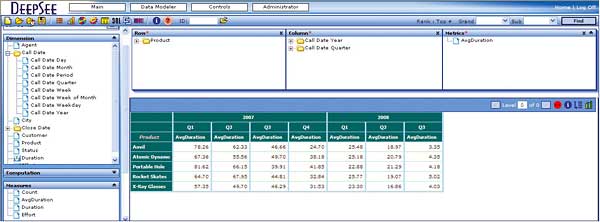DeepSee from InterSystems is designed to give you an alternative. In a nutshell, it’s a real-time BI solution that is designed to be embedded into transactional applications. The fact that it lives within such applications means that when you analyse data, you’re working on current data rather than the stale data stored in a data warehouse.
The traditional remit of BI has been to deliver reports and data to management information systems. Data has been extracted from transactional databases, cleaned using ETL (Extract, Transform, Load) techniques, then placed in a data warehouse or data mart for later analysis using specialist BI tools. The problem with this is that the process takes time; data might be a week old, it might be a month old. For many BI uses this is acceptable, but such data can’t be used to make business decisions on current actions – it can’t be used to answer the question “how can we maximise the value of this transaction?”
DeepSee is designed for applications that can be used to answer such questions. It isn’t designed to replace traditional BI environments, but to provide real-time business intelligence for transactional systems. The technology relies on the strong indexing abilities developed by InterSystems in its Caché database. Having good indices is vital because a business user can’t wait minutes for an answer to a real-time question; the response has to be almost instantaneous.
The system is also designed to be scalable. A standard BI system will probably be used by senior and middle management, so the number of users will be relatively low. In contrast, DeepSee applications will be aimed at normal business users, so may well be required to provide embedded BI to everybody within an organisation from the CEO to the front-line.

DeepSee provides business users with data organised into hierarchies for analysis
One limitation for traditional BI systems is the fact that they are difficult to use. Many BI implementations are designed by specialist consultants, who analyse the data model, work out how the data should be made available in terms of data hierarchies, what should form the OLAP cubes, and similar underlying structures. This is provided as a pre-packaged environment, and the users essentially interact in a passive way. The focus of DeepSee is very different. Intersystems has always focused on the application development community, and DeepSee is aimed at that same target audience – developers who are building applications and want to be able to deliver business intelligence in the form of dashboards, reports, and analyses of underlying data within their application to provide more value to the people using their products. Using DeepSee, the developers will be able to provide facilities for their end users to create reports and dashboards using point and click designers and basic skills.
DeepSee consists of four components starting with DeepSee Architect, where the developer defines the data model. This has to be highly indexed to deliver BI capabilities. Next comes DeepSee Designer. This is used to create dashboards and high-level views of the underlying data model. DeepSee Analyzer provides the traditional BI facilities – you can slice and dice the data, drill down to see more detailed information, create charts, export the results, and save analyses so that different users can make use of them. You can also drill through to the individual transactions. The final module recognises the fact that in most organisations, data is not located in one application; it’s found in a variety of applications and a successful BI application needs to have a way to connect to external data. DeepSee Connector does just that giving developers data held in other applications a way to use it within their applications.
DeepSee won’t be replacing all traditional BI systems. If a company has a data warehouse with reporting tools running on top of it, and the system provides all the analysis and answers the business needs, there will be no compelling reason to move. However, if an organisation is looking for more real-time answers, where the data needs to be fresher, DeepSee becomes very relevant. It will also be very relevant in cases where application developers are providing BI functionality by running a BI tool on top of their application. In this case, the reports produced can only be run on static versions of the data, and the answers provided must therefore be at least partially out of date. DeepSee will let those developers embed the BI within the application, so that the reports can be run against the current transactional data. This won’t be a necessity for everyone. If your customers tend to want to look at financial results over the last quarter, real-time isn’t an issue. On the other hand, if they want to bring BI techniques to transactions they’re doing right now, DeepSee may just be the way to go.
Kay Ewbank, the editor of Server Management magazine, is an experienced database analyst.
Comments